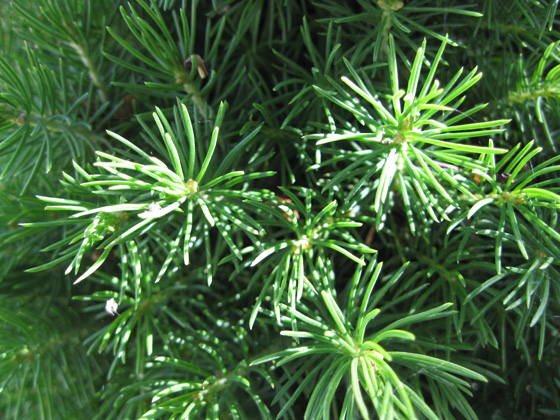| PSC 2620: Woody Trees and Shrub | Course Home | Week 12 |
Picea glauca 'Conica' - Dwarf Alberta Spruce
Plant Viewer
 |
 |
| The small needles are a bright green or blue-green color and are arranged radially around the stem, with the needles curving slightly towards the stem tip. | The swollen buds where new growth forms can be easily mistaken for cones, which rarely form. |
Plant Description
Picea glauca 'Conica', or Dwarf Alberta Spruce, is a popular small coniferous evergreen tree, growing very slowly to 10-12 feet high and 5-7 feet wide. It is a cultivar of Picea glauca or White Spruce. They have a very dense branching habit and needle coverage, and a strongly conical form reminiscent of a Christmas Tree. It needs ample moisture when it is getting established, and always requires a moderate amount of moisture to prevent sun burn, but prefers well-drained soil. I have seen this cultivar perform well when planted in full sun or full shade.
The needles are small, 1/4 - 1 1/2 inches long, and bright green to blue-green in color. They radiate around the stem and curve noticeably towards the end of the branches. Despite the fluffy and soft visual texture of the tree, the needles are quite stiff and sharp. The terminal buds are small and swelled in appearance, and can be mistaken for cones, which rarely form on the plant.
Landscape Use
Commonly used as an accent plant because of its natural cone shape. It is commonly used as a foundation plantings, but should only be done so on the north or east side of a building to avoid damage to the foliage from reflective heat.
Points of Interest
It is damaged by salt, and so should not be used in a location where winter snow will be plowed onto it. Snow loads can damage the conical form and many people wrap them in burlap over winter. Mites can be problematic and, in bad cases, can lead to defoliation. Most damage to specimens in our climate occurs from a lack of water or from being subjected to high amounts of reflective heat or light.
Notable Cultivars
Rainbow's End
The new growth emerges yellow, giving the tree the appearance that it has been dusted with gold.
